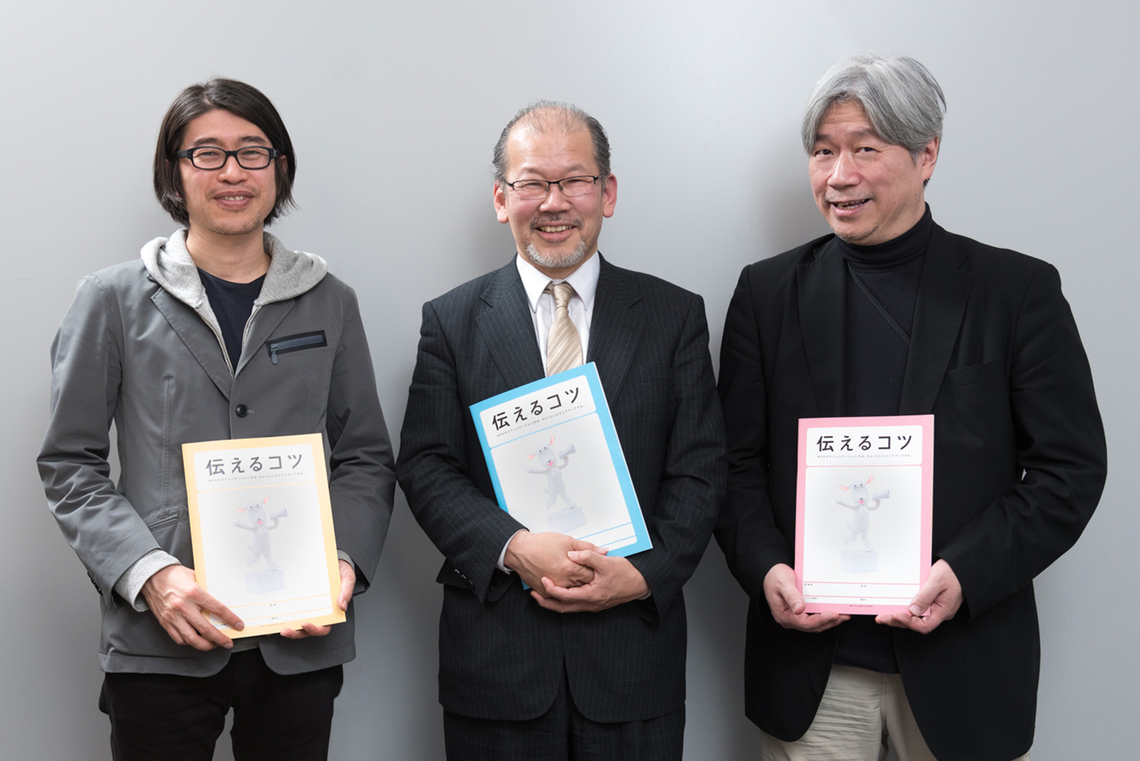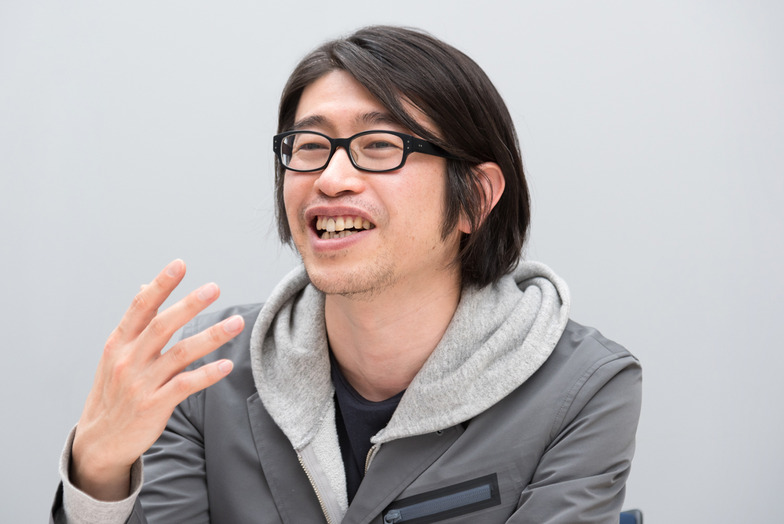This series features columns by Nadezhda Kirillova of the lab and dialogues with Professor Masashi Okuma, a lab member, and other members.
The theme of the second discussion is "The Art of Communication." "The Art of Communication" is a social contribution program run by Dentsu Inc., offering workshop-style support to strengthen communication skills for NPO representatives nationwide.
Professor Masashi Okuma, Shigetomi Ishida, Director of Dentsu Inc. 2CRP Bureau, and Hidetoshi Kurashige, Director of the Institute, served as facilitators, discussing the key elements from "The Art of Communication" that could be applied to active learning.
Kurashige: First, could you remind us what "The Art of Communication" is?
Ishida: It's Dentsu Inc.'s corporate social responsibility (CSR) initiative. It started 12 years ago when someone outside the company said, "NPOs face various challenges; we should use Dentsu Inc.'s expertise to help them."
We believed the fundamentals were crucial. We started by ensuring we could clearly communicate who we are, what we do, and what kind of support we seek.
Kurashige: Looking at the text, this is all exactly what you do when creating ads at Dentsu Inc., isn't it?
Ishida: Exactly. We share the skills we've honed in our professional work with NPO members who have less communication experience. Since these individuals are becoming the new leaders of society, we believe sharing Dentsu Inc.'s core expertise contributes to social good. We feel providing know-how close to our core business, rather than just financial aid, is a more effective CSR activity.
Initially, we considered creating and distributing a book, but due to strong requests from the NPOs, we decided to proceed with a workshop format.
Dentsu Inc.'s in-house advertising creators became instructors, holding nearly 120 workshops across all prefectures nationwide. We've shared "Communication Tips" with approximately 4,800 NPO members.
Kurashige: Has the "Communication Tips" booklet been revised multiple times?
Ishida: We've addressed minor issues like excessive use of katakana. When it started, the internet and social media weren't prevalent, so recent revisions also cover web-centric communication methods. That said, the essence of "Communication Tips" remains unchanged.
Kurashige: Have you received any positive feedback from participants?
Ishida: We've heard comments like, "I realized that organizing our own thoughts is crucial before diving into techniques," and "It was truly eye-opening." Participants have also recommended the workshop to acquaintances, saying, "You absolutely must take this workshop."
Previously, we held a workshop comparing before and after the training. The organization's newsletter transformed completely compared to its pre-workshop version. It became much more human and appealing, which surprised even us.
This "knack" was completely absent in the educational field
Kurashige: Professor Okuma, what do you think after seeing this booklet?
Okuma: Seeing "The Art of Communication" was a shock. I'd never learned these things before, nor could I teach them. I worked as an elementary school teacher, then as a supervising instructor, and later at the Board of Education. Throughout that experience, I never once consciously considered "the art of communication."
Even when the Board of Education asked schools to "create a website," we distributed website creation software, but there were zero instructions on how to actually build the site or how to communicate effectively. Earlier, you mentioned the NPO members saying it was "eye-opening" – that's exactly how it was.
The Ingenious Process Leading to "One-Phrase Communication"
Kurashige: I recently participated in a workshop in Kumamoto myself, and it really drove home why you insist on face-to-face workshops instead of just distributing booklets. Could you explain the flow?
Ishida: The foundation is the booklet "PART 1: Mindset Edition," which we cover thoroughly. We start with "Communication Tip 01: Begin by looking inward." Rather than focusing on what to tell others, participants first organize their own identity.
Next is "Communication Tip 02: Consider How Others See You." Even if you think you understand, others might not. We make participants conscious of "how their group is perceived" and consider how they want to be seen.
"Communication Tip 03: Clarify Your Organization's Purpose" involves listing "What you've achieved so far," "What you haven't achieved yet," and "What you should do going forward."
This reveals the organization's challenges. So, in "Communication Tip 04: Clearly Identify the Organization's Challenges," we organize the challenges we want to solve.
Furthermore, in "Communication Tip 05: Define 'Who' and 'What' You Want to Communicate," you visualize your target audience concretely. Once your audience is clear, your message delivery and tone will naturally become more vibrant.
Finally, we distill it into a single phrase. At the end of "PART 1," "Communication Tip 06: Summarize Your Activities in One Phrase," we create a slogan conveying the essence of the activity. In fact, all the previous steps were preparatory exercises leading up to this point.
Ōkuma: It's very well done, isn't it? Normally, you'd start with "Communication Tip 06." But by going through steps 01 to 06 sequentially, it creates a path where participants actively develop solutions themselves.
Instead of imposing conclusions like "This is how you should do it" from the start, it first makes participants realize they don't fully understand themselves and that their message isn't getting across to others. Learners develop a "desire to solve the problem," then the challenge is clarified, and they build on that to learn.
The active learning currently trending in education isn't just about "being energetic" or "being active." I believe true active learning is a teaching process where participants, by going through a specific sequence, become proactive in seeking solutions and can then concretely solve problems. "The Art of Communication" embodies this perfectly.
Once you understand your audience, the "tone and manner" becomes clear.
Kurashige: "The Art of Communication" enters its practical phase starting from "PART 2," right?
Ishida: "PART 2: Practical Application" details methods for effective communication. For example: "Reduce the amount of information," "Set priorities," and "Consider the tone and manner of your expression." Then, "PART 3: Advanced Application" covers how to convey your information through media and SNS, including concrete guidance on writing press releases. Finally, "PART 4: Collaboration" touches on methods for increasing supporters.
Ōkuma: I wish I'd read this Practical Guide sooner. My wife once asked me to draft an event flyer, and when I wrote it in the same style as an education board document, she rejected it saying, "No one will come with a flyer like this."
Looking back, it was indeed written in that condescending, board-of-education style. I reflected and changed my approach. When I adopted the tone used in elementary school class newsletters, it was praised as much better. I hadn't realized that writing has its own "tone and manner" – essentially, the way you convey your message – and that I needed to consider that.
Active learning is
digging out the answers within yourself
Kurashige: I think it's good that introducing active learning increases questions without clear answers. What you say is free, and how you do it is free. "PART 1: The Mindset" in "Tips for Effective Communication" is exactly that kind of process, right?
Ishida: If you have a clear image of the goal, there are many correct paths to reach it. That's exactly what we convey in "Tips for Effective Communication."
Kurashige: Beyond that, I think it's valuable to teach children from an early age that there's no single right answer for the tone and manner of expression – the "how" of communication. There's this vague notion that essays must be written a certain way. But the truth is, the patterns are infinite. Using casual speech is fine, or conversely, writing in a very formal style is acceptable. Finishing with one long sentence is perfectly valid too. Understanding this could spark greater interest in expressing oneself.
Okuma: Smart kids were good at figuring out what the teacher had in mind as the "correct" answer. I was like that too. But with active learning, the teacher's idea of a "correct" answer doesn't matter. What you're seeking isn't on the teacher's side, but within your own heart.
I call it "that uneasy feeling in your chest." When you go through the process of looking inward and discovering problems, something within you—that uneasy feeling you need to resolve—emerges as the challenge. Today, I confirmed that this process is the key to effective communication.
Kurashige: Today we discussed how skills from the advertising industry can be applied to education. Conversely, through my interactions with Professor Okuma, I've learned that many skills from the education field can be applied to business. Things like "how to create an atmosphere where everyone feels comfortable speaking up," "how giving instructions after the fact can lead to classroom breakdown," or "methods for building confidence while maintaining a certain level of risk." We could talk about this all night.
I truly believe the world would become so much more interesting if we saw more mutual emergence between business and education. I'm planning to start many such initiatives going forward. Let's dive right in together. Thank you for today.













